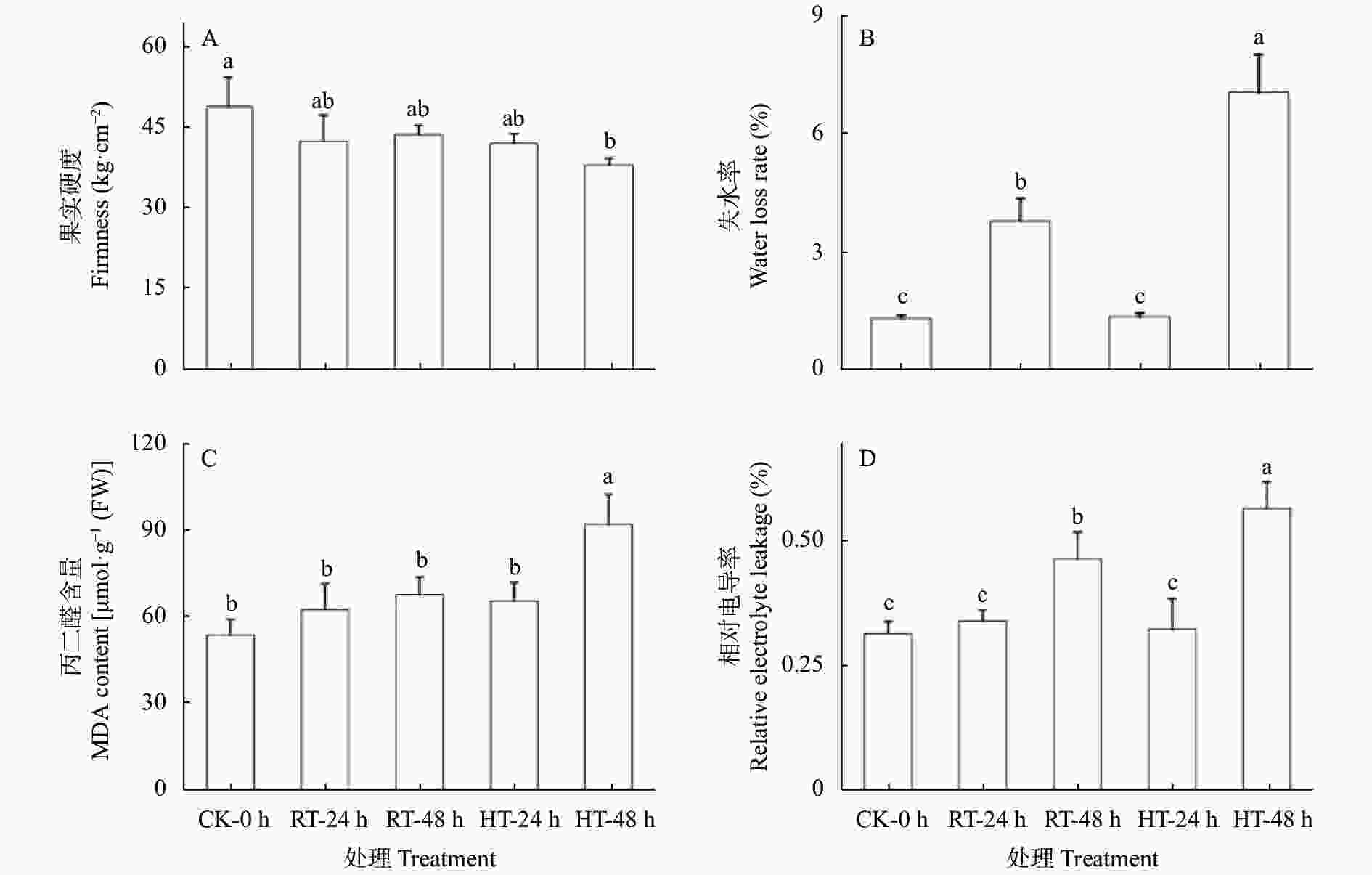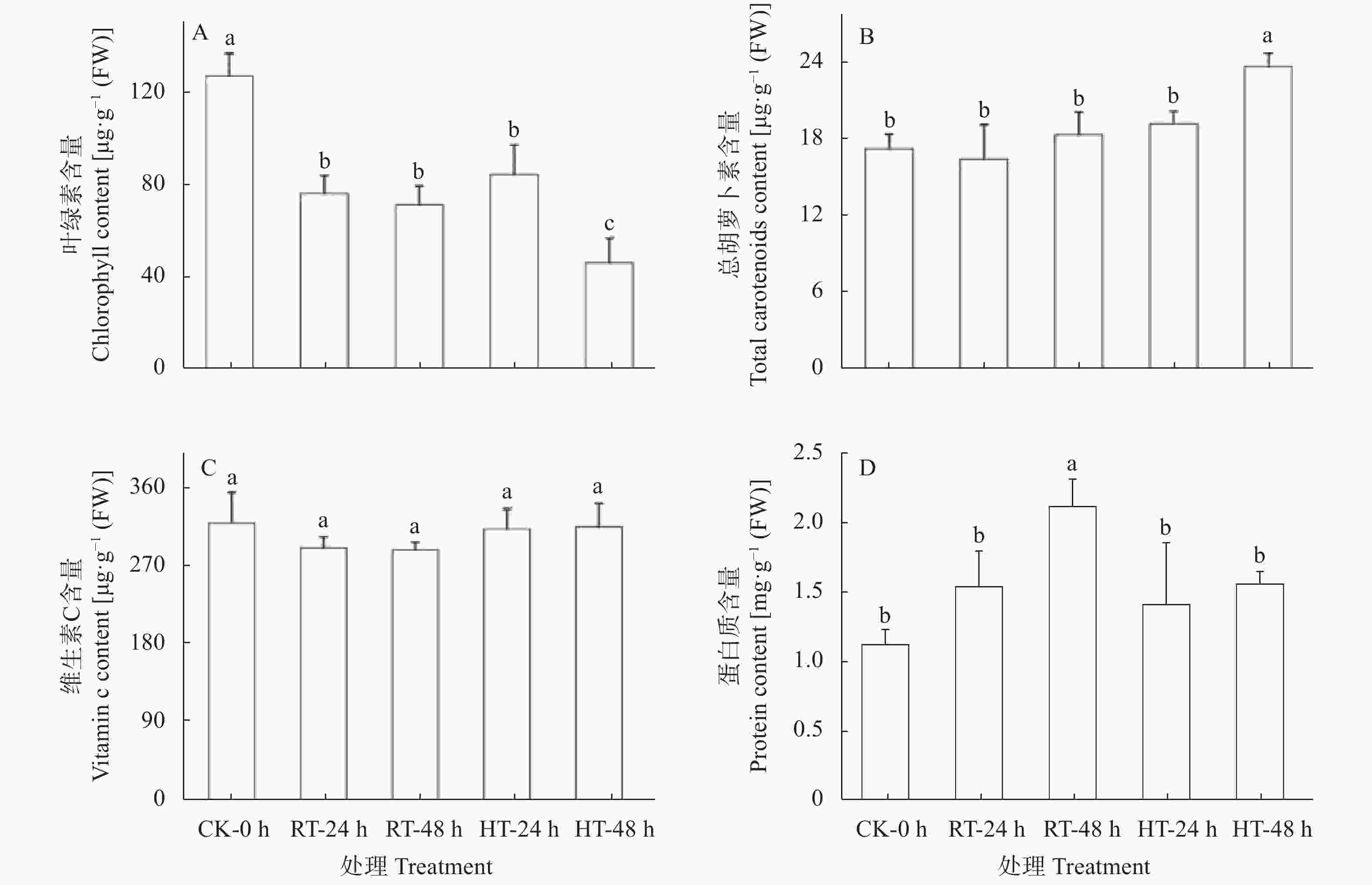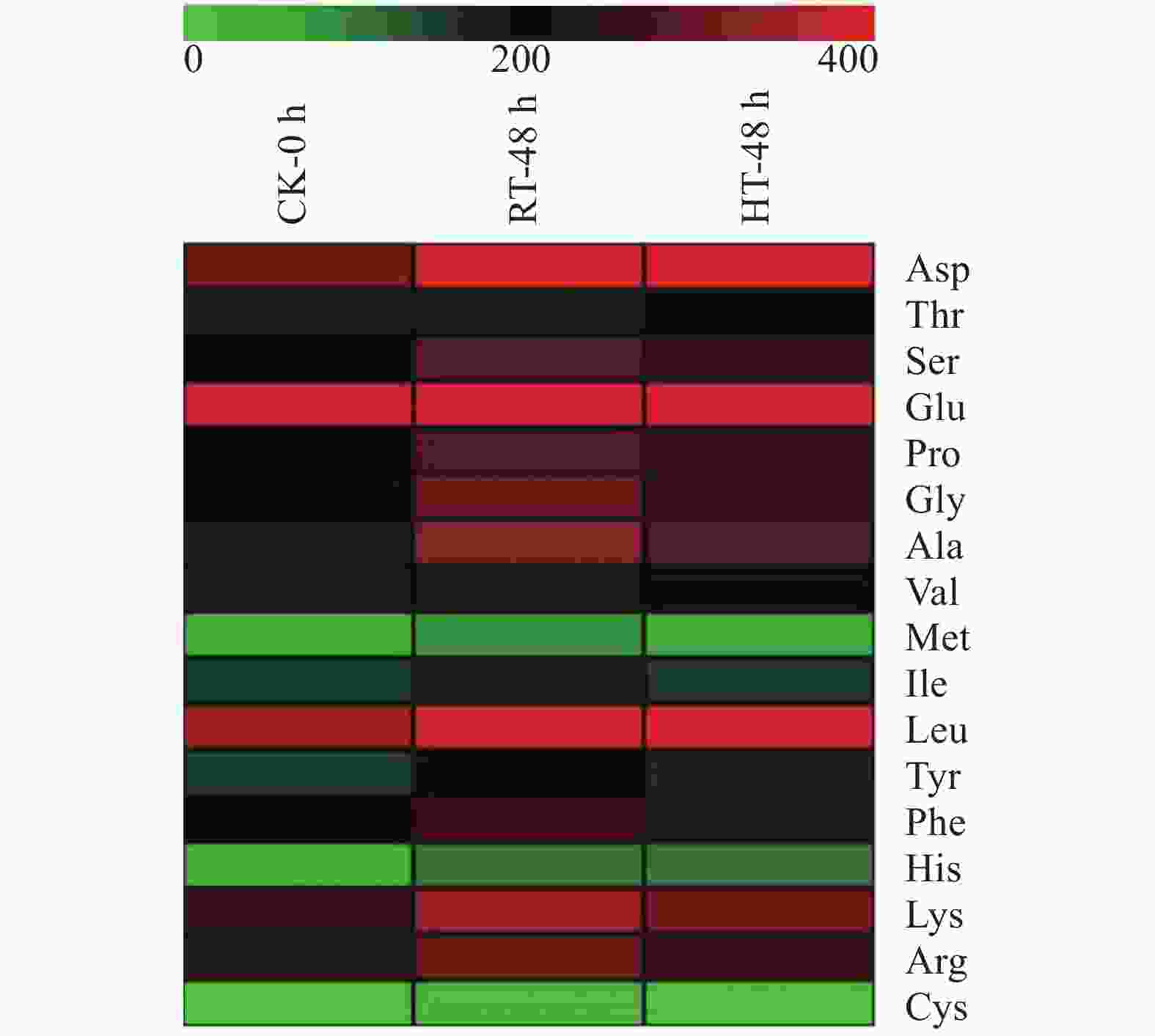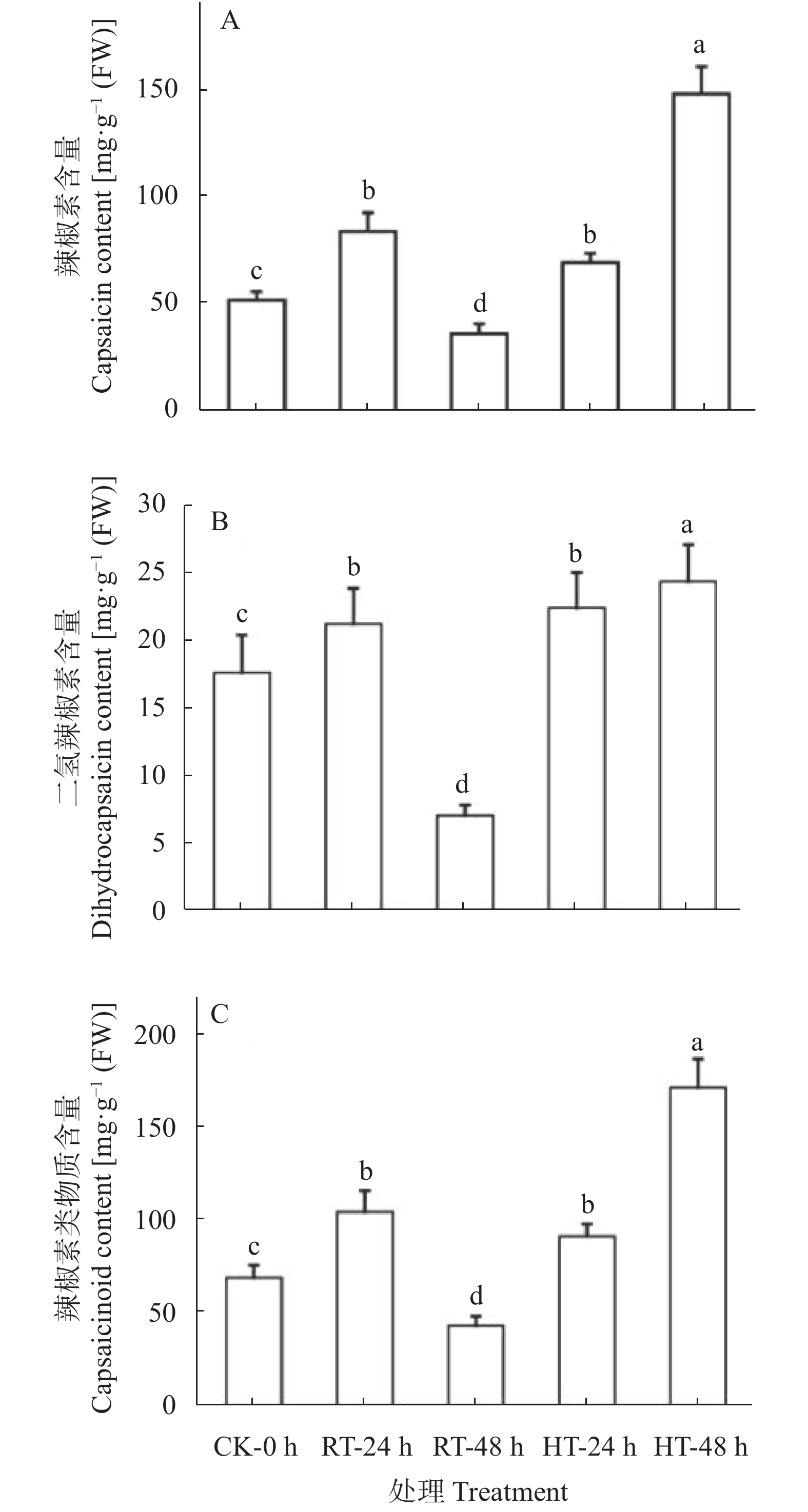Effects of storage temperature on the post-harvest quality of chili pepper (Capsicum annum L.)
-
摘要: 为探究不同贮藏温度对采后辣椒果实品质的影响, 本研究模拟辣椒田间生产中的贮藏温度条件——常温(20 ℃)和高温(30 ℃), 对辣椒(Capsicum annum L.)品种‘P1808’的绿熟期果实进行短期贮藏, 并在贮藏后24 h和48 h分别对果实硬度、失水率、辣椒素类物质、氨基酸含量等商品性、风味和营养品质相关指标进行测定和比较分析。研究结果表明, 常温贮藏24 h和48 h条件下, 辣椒素类物质含量先升高后降低(24 h升高50%以上), 叶绿素类物质下降后维持在一定水平, 而失水率、相对电导率和蛋白质含量呈逐步上升趋势。而高温贮藏24 h和48 h条件下, 辣椒素类物质含量逐步升高(24 h升高近50%, 48 h升高近150%), 叶绿素含量逐步下降, 硬度48 h后显著下降, 而失水率、丙二醛、相对电导率和总胡罗卜素含量显著上升。对不同温度贮藏48 h后的辣椒果实氨基酸组成和营养价值分析结果表明, 不论是常温还是高温, 贮藏48 h后辣椒果实中不同种类氨基酸均有一定程度的积累, 而常温贮藏在提升总氨基酸、人体必需氨基酸、儿童必需氨基酸及各类风味相关氨基酸的含量上效果尤为显著。从氨基酸营养价值角度考虑, 蛋氨酸+胱氨酸是辣椒果实的第一限制氨基酸, 与对照相比, 常温和高温贮藏48 h均会导致辣椒果实中缬氨酸和异亮氨酸均低于氨基酸模式谱标准。本研究结果有望为田间辣椒贮藏保鲜提供理论支撑和实践指导。Abstract: This study explored the effects of different storage temperatures on the postharvest quality of pepper fruits. A pepper cultivar (P1808) bred by the Zhejiang Academy of Agricultural Sciences was used in this study. Pepper fruits at the green ripe stage were collected and kept at room temperature (RT, 20 °C) or high temperature (HT, 30 °C) for 24 h and 48 h. Thereafter, the quality-related parameters of pepper fruits, including firmness, water loss rate, as well as contents of capsaicinoids, vitamin C, and amino acid, were analyzed. The results showed that under RT storage, the capsaicinoid content increased by more than 50% after 24 h and then decreased after 48 h, respectively; and the chlorophyll content decreased and remained at the same level after 24 h and 48 h, respectively; however, the water loss rate, relative electrolyte leakage, and protein content showed a tendency of continuous accumulation up to 48 h. Under the HT storage treatment, the capsaicinoid content gradually increased by approximately 50% and 150% after 24 h and 48 h, respectively; while the chlorophyll content continuously declined. After 48 h, the fruit firmness decreased significantly, while other parameters, including the water loss rate, malondialdehyde content, relative electrolyte leakage, and total carotenoid content, increased. The results of amino acid composition and nutritional value analysis of the pepper fruits under different temperature storage treatments showed that both the RT and HT treatments promoted the accumulation of 17 amino acids after 48 h. Further analysis based on the functional classification of amino acids indicated that the RT treatment significantly increased the content of total amino acids, essential amino acids, amino acids essential for children, and flavor-related amino acids. From the perspective of the nutritional value of amino acids, methionine and cystine were proved to be the main limiting amino acids in the pepper fruits; after 48 h, both the RT and HT storage treatments led to a decreased pattern of valine and isoleucine compared to the amino acid pattern spectrum in the pepper fruits. Ultimately, this study provides theoretical and practical guidance for postharvest maintenance of the quality of pepper fruits.
-
Key words:
- Pepper /
- Fruits at green ripe stage /
- Storage temperature /
- Fruit quality
-
图 1 常温和高温贮藏24 h和48 h后辣椒果实的辣椒素(A)、二氢辣椒素(B)和辣椒素类(C)含量
CK-0 h: 贮藏前(对照); RT-24: 常温贮藏24 h; RT-48 h: 常温贮藏48 h; HT-24: 高温贮藏24 h; HT-48 h: 高温贮藏48 h。不同小写字母表示不同处理在P<0.05水平差异显著。辣椒素类物质含量=辣椒素含量+二氢辣椒素含量。CK-0 h: before treatment (control); RT-24: storage at room temperature for 24 hours; RT-48 h: storage at room temperature for 48 hours; HT-24: storage at high temperature for 24 hours; HT-48 h: storage at high temperature for 48 hours. Different lowercase letters indicate significant differences among treatmenst at P<0.05 level. Capsaicinoid= capsaicin+dihydrocapsaicin.
Figure 1. Capsaicin (A), dihydrocapsaicin (B), capsaicinoid (C) contents of pepper fruits stored at room and high temperatures for 24 and 48 hours
图 2 常温和高温贮藏24 h和48 h后辣椒果实硬度(A)、失水率(B)、丙二醛含量(C)和相对电导率(D)变化
CK-0 h: 贮藏前(对照); RT-24: 常温贮藏24 h; RT-48 h: 常温贮藏48 h; HT-24: 高温贮藏24 h; HT-48 h: 高温贮藏48 h。不同小写字母表示不同处理在P<0.05水平差异显著。失水率(%)=(处理前果实重量–处理后果实重量)/处理前果实重量×100。CK-0 h: before treatment (control); RT-24: storage at room temperature for 24 hours; RT-48 h: storage at room temperature for 48 hours; HT-24: storage at high temperature for 24 hours; HT-48 h: storage at high temperature for 48 hours. Different lowercase letters indicate significant differences among treatments at P<0.05 level. Water loss rate (%) = (pre-treatment fruit weight – after-treatment fruit weight) /pre-treatment fruit weight×100.
Figure 2. Fruit firmness (A), water loss rate (B), malondialdehyde (MDA) content (C), and relative electrolyte leakage (D) of pepper fruits stored at room and high temperatures for 24 and 48 hours
图 3 常温和高温贮藏辣椒果实叶绿素含量(A)、总胡萝卜素含量(B)、维生素C含量(C)、蛋白质含量(D)变化
CK-0 h: 贮藏前(对照); RT-24: 常温贮藏24 h; RT-48 h: 常温贮藏48 h; HT-24: 高温贮藏24 h; HT-48 h: 高温贮藏48 h。不同小写字母表示不同处理在 P<0.05水平差异显著。CK-0 h: before treatment (control); RT-24: storage at room temperature for 24 hours; RT-48 h: storage at room temperature for 48 hours; HT-24: storage at high temperature for 24 hours; HT-48 h: storage at high temperature for 48 hours. Different lowercase letters indicate significant differences among treatments at P<0.05 level.
Figure 3. Chlorophyll (A), total carotenoids content (B), vitamin C content (C), and protein content (D) of pepper fruits under room temperature and high temperature storage
图 4 常温(RT-48 h)和高温(HT-48 h)贮藏48 h辣椒果实不同种类氨基酸含量变化
CK-0 h: 贮藏前(对照); RT-48 h: 常温贮藏48 h; HT-48 h: 高温贮藏48 h。Asp: 天冬氨酸; Thr: 苏氨酸; Ser: 丝氨酸; Glu: 谷氨酸; Pro: 脯氨酸; Gly: 甘氨酸; Ala: 丙氨酸; Val: 缬氨酸; Met: 蛋氨酸; Ile: 异亮氨酸; Leu: 亮氨酸; Tyr: 酪氨酸; Phe: 苯丙氨酸; His: 组氨酸; Lys: 赖氨酸; Arg: 精氨酸; Cys: 半胱氨酸。CK-0 h: before treatment (control); RT-48 h: storage at room temperature for 48 hours; HT-48 h: storage at high temperature for 48 hours. Asp: aspartic acid; Thr: threonine; Ser: serine; Glu: glutamine; Pro: proline; Gly: glycine; Ala: alanine; Vla: valine; Met: methionine; Ile: isoleucine; Leu: leucine; Tyr: tyrosine; Phe: phenylalanine; His: histidine; Lys: lysine; Arg: arginine; Cys: cysteine.
Figure 4. Effects of room temperature (RT-48 h) and high temperature (HT-48 h) storage for 48 h on the changes of amino acid composition and contents in pepper fruits
表 1 常温(RT-48 h)和高温(HT-48 h)贮藏48 h对辣椒果实中氨基酸含量和构成的影响
Table 1. Effect of room temperature (RT-48 h) and high temperature (HT-48 h) storage for 48 h on amino acid contents and composition of pepper fruits
氨基酸 Amino acid CK-0 h RT-48 h HT-48 h 变异系数 CV (%) 名称 Name 类别 Group 天冬氨酸
Aspartic acid非必需氨基酸、鲜味氨基酸
Non-essential amino acid, tasty amino acid305.39 429.44 393.01 16.96 苏氨酸
Threonine必需氨基酸
Essential amino acid172.40 236.95 209.99 15.70 丝氨酸
Serine非必需氨基酸、甜味氨基酸
Non-essential amino acid, sweet amino acid201.11 281.69 250.39 16.62 谷氨酸
Glutamine非必需氨基酸、鲜味氨基酸
Non-essential amino acid, tasty amino acid417.99 576.98 500.73 15.95 脯氨酸
Proline非必需氨基酸、甜味氨基酸
Non-essential amino acid, sweet amino acid197.05 278.20 205.93 16.99 甘氨酸
Glycine非必需氨基酸、甜味氨基酸
Non-essential amino acid, sweet amino acid214.66 299.64 268.21 16.47 丙氨酸
Alanine非必需氨基酸、甜味氨基酸
Non-essential amino acid, sweet amino acid232.14 323.96 282.52 16.45 缬氨酸
Valine必需氨基酸
Essential amino acid175.04 226.27 190.85 13.29 蛋氨酸
Methionine必需氨基酸
Essential amino acid44.77 74.20 59.11 20.79 异亮氨酸
Isoleucine必需氨基酸
Essential amino acid140.06 175.12 151.78 11.47 亮氨酸
Leucine必需氨基酸
Essential amino acid308.04 477.09 418.55 15.59 酪氨酸
Tyrosine非必需氨基酸、芳香族氨基酸
Non-essential amino acid, aromatic amino acid146.11 190.22 163.45 13.30 苯丙氨酸
Phenylalanine必需氨基酸、芳香族氨基酸
Essential amino acid, aromatic amino acid201.30 271.18 235.28 14.80 组氨酸
Histidine非必需氨基酸、儿童必需氨基酸
Non-essential amino acid, children essential amino acid58.71 97.11 99.40 26.87 赖氨酸
Lysine必需氨基酸
Essential amino acid258.77 337.58 301.33 13.18 精氨酸
Arginine非必需氨基酸、儿童必需氨基酸
Non-essential amino acid, children essential amino acid236.76 301.99 252.03 12.94 半胱氨酸
Cysteine非必需氨基酸
Non-essential amino acid14.19 20.82 18.94 18.98 总氨基酸
Total amino acids3364.53 4598.43 4041.50 15.44 必需氨基酸占比
Ratio of essential amino acids (%)39.84 39.11 38.77 1.39 非必需氨基酸占比
Ratio of non-essential amino acids (%)60.16 60.89 61.23 0.90 儿童必须氨基酸占比
Ratio of children essential amino acids (%)8.78 8.68 8.70 0.63 鲜味类氨基酸占比
Ratio of tasty amino acids (%)21.50 21.89 22.11 1.41 甜味类氨基酸占比
Ratio of sweet amino acids (%)25.12 25.75 25.92 1.65 芳香族氨基酸占比
Ratio of aromatic amino acids (%)10.32 10.04 9.86 2.30 CK-0 h: 贮藏前(对照)。必需氨基酸占比(%)=必需氨基酸/总氨基酸×100; 非必需氨基酸占比(%)=非必需氨基酸/总氨基酸×100; 儿童必需氨基酸占比(%)=儿童必需氨基酸/总氨基酸×100; 鲜味氨基酸占比(%)=鲜味氨基酸/总氨基酸×100; 甜味氨基酸占比(%)=甜味氨基酸/总氨基酸×100; 芳香族氨基酸占比(%)=芳香族氨基酸/总氨基酸×100。CK-0 h: before treatment (control). Ratio of essential amino acids (%)=essential amino acids/total amino acids×100; ratio of non-essential amino acids (%)=non-essential amino acids/total amino acids×100; ratio of children essential amino acids (%)=children essential amino acids/total amino acids×100, ratio of tasty amino acids (%)=tasty amino acids/total amino acids×100; ratio of sweet amino acids (%)=sweet amino acids/total amino acids×100; ratio of aromatic amino acids (%)=aromatic amino acids/total amino acids×100; RT-48 h: storage at room temperature for 48 hours; HT-48 h: storage at high temperature for 48 hours. 表 2 人体必需氨基酸的组成比例与氨基酸模式谱的比较
Table 2. Analysis of human essential amino acid ratio of pepper fruit stored at room and high temperatures for 0 and 48 hours according to the amino acid pattern spectrum
氨基酸种类 Amino acid type 氨基酸模式谱 Amino acid pattern pectrum CK-0 h RT-48 h HT-48 h 平均值 Average 变异系数 CV (%) 苏氨酸 Threonine 4.00 5.12 5.15 5.20 5.16±0.04 0.78 缬氨酸 Valine 5.00 5.20 4.92 4.72 4.95±0.20 4.90 异亮氨酸 Isoleucine 4.00 4.16 3.81 3.76 3.91±0.22 5.72 亮氨酸 Leucine 7.00 10.30 10.38 10.36 10.36±0.02 0.19 赖氨酸 Lysine 5.50 7.69 7.30 7.46 7.50±0.18 2.42 蛋氨酸+半胱氨酸 Methionine + cysteine 3.50 1.75 2.07 1.93 1.92±0.16 7.75 苯丙氨酸+酪氨酸 Phenylalanine + tyrosine 6.00 10.33 10.03 9.87 10.08±0.23 2.33 CK-0 h: 贮藏前(对照); RT-48 h: 常温贮藏48 h; HT-48 h: 高温贮藏48 h。CK-0 h: before treatment (control); RT-48 h: storage at room temperature for 48 hours; HT-48 h: storage at high temperature for 48 hours. -
[1] 朱德蔚, 王德槟, 李锡香. 中国作物及其野生近缘植物(蔬菜作物卷)[M]. 北京: 中国农业出版社, 2008: 704–746ZHU D W, WANG D B, LI X X. Crop and Their Wild Relatives in China (Vol. Vegetable Crops)[M]. Beijing: China Agriculture Press, 2008: 704–746 [2] 邹学校, 马艳青, 戴雄泽, 等. 辣椒在中国的传播与产业发展[J]. 园艺学报, 2020, 47(9): 1715−1726ZOU X X, MA Y Q, DAI X Z, et al. Spread and industry development of pepper in China[J]. Acta Horticulturae Sinica, 2020, 47(9): 1715−1726 [3] 须海丽. 辣椒品质育种研究进展[J]. 长江蔬菜, 2004(2): 34–37XU H L. Research progress of quality breeding in hot pepper (Capsicum annuum L.)[J]. Journal of Changjiang Vegetables, 2004(2): 34–37 [4] CATERINA M J. Impaired nociception and pain sensation in mice lacking the capsaicin receptor[J]. Science, 2000, 288(5464): 306−313 doi: 10.1126/science.288.5464.306 [5] SURI A, SZALLASI A. The emerging role of TRPV1 in diabetes and obesity[J]. Trends in Pharmacological Sciences, 2008, 29(1): 29−36 doi: 10.1016/j.tips.2007.10.016 [6] 田方. 辣椒素类似物的生物转化和预防肥胖作用研究[D]. 天津: 河北工业大学, 2009TIAN F. Study on biotransformation and intervening obesity action of capsaicin analog[D]. Tianjin: Hebei University of Technology, 2009 [7] 张磊. 辣椒碱降大鼠胆固醇效果及其分子机理的研究[D]. 重庆: 西南大学, 2013ZHANG L. Research on hypocholesterolemic effects and mechanism of capsaicinoids on cholesterol metabolic in vivo and vitro[D]. Chongqing: Southwest University, 2013 [8] DE NAVES E R, DE ÁVILA SILVA L, SULPICE R, et al. Capsaicinoids: pungency beyond Capsicum[J]. Trends in Plant Science, 2019, 24(2): 109−120 doi: 10.1016/j.tplants.2018.11.001 [9] 中国百科全书(蔬菜卷)[M]. 北京: 农业出版社, 1984: 136Enyclopedia of China (Vol. Vegetable Crops) [M]. Beijing: Agriculture Press, 1984: 136 [10] 李莎, 杨苗, 南羽, 等. 四川省不同地理环境下辣椒果实辣椒碱及VC含量差异[J]. 长江蔬菜, 2015(10): 27–31LI S, YANG M, NAN Y, et al. Content differences in capsaicinoids and vitamin C of peppers cultivated under different geographical environments in Sichuan Province[J]. Journal of Changjiang Vegetables, 2015(10): 27–31 [11] 高伦江, 曾小峰, 贺肖寒, 等. 辣椒采后贮藏生理及保鲜技术研究进展[J]. 南方农业, 2019, 13(1): 96−100GAO L J, ZENG X F, HE X H, et al. Research progress on postharvest storage physiology and preservation technology of pepper[J]. South China Agriculture, 2019, 13(1): 96−100 [12] SUN B, TIAN Y X, JIANG M, et al. Variation in the main health-promoting compounds and antioxidant activity of whole and individual edible parts of baby mustard (Brassica juncea var. gemmifera)[J]. RSC Advances, 2018, 8(59): 33845−33854 doi: 10.1039/C8RA05504A [13] MATSUMOTO H, IKOMA Y, KATO M, et al. Effect of postharvest temperature and ethylene on carotenoid accumulation in the flavedo and juice sacs of Satsuma mandarin (Citrus unshiumarc. ) fruit[J]. Journal of Agricultural and Food Chemistry, 2009, 57(11): 4724−4732 doi: 10.1021/jf9005998 [14] GAUTIER H, DIAKOU-VERDIN V, BÉNARD C, et al. How does tomato quality (sugar, acid, and nutritional quality) vary with ripening stage, temperature, and irradiance?[J]. Journal of Agricultural and Food Chemistry, 2008, 56(4): 1241−1250 doi: 10.1021/jf072196t [15] NISHINO A, YASUI H, MAOKA T. Reaction of paprika carotenoids, capsanthin and capsorubin, with reactive oxygen species[J]. Journal of Agricultural and Food Chemistry, 2016, 64(23): 4786−4792 doi: 10.1021/acs.jafc.6b01706 [16] YAMAUCHI N. Postharvest chlorophyll degradation and oxidative stress[M]//Abiotic Stress Biology in Horticultural Plants. Tokyo: Springer Japan, 2014: 101–113 [17] WANG C Y. Chilling Injury of Horticultural Crops[M]. Boca Raton, FL: CRC Press, 1990 [18] HAMEED R, MALIK A U, KHAN A S, et al. Evaluating the effect of different storage conditions on quality of green chillies (Capsicum annuum L.)[J]. Tropical Agricultural Research, 2015, 24(4): 391 [19] 许海峰, 陈新, 张士刚, 等. 基于代谢组学分析‘秋香’核桃贮藏期间脂肪酸的变化[J]. 园艺学报, 2021, 48(11): 2161–2170XU H F, CHEN X, ZHANG S G, et al. Change of fatty acid during storage period of ‘Qiuxiang’ walnut based on metabolomics analysis[J]. Acta Horticulturae Sinica, 2021, 48(11): 2161–2170 [20] 郭慧静, 李自芹, 李冀新, 等. 不同保鲜处理对新疆吊干杏贮藏品质及保鲜效果的影响[J]. 食品工业, 2021, 42(12): 313−318GUO H J, LI Z Q, LI J X, et al. Effects of different preservation treatments on preservation effectand storage quality of Xinjiang Diaogan apricot[J]. The Food Industry, 2021, 42(12): 313−318 [21] 周颖军. 热处理技术在果蔬贮藏中的应用研讨[J]. 黑龙江科学, 2017, 8(19): 24−25 doi: 10.3969/j.issn.1674-8646.2017.19.012ZHOU Y J. Application of heat treatment technology in fruit and vegetable storage[J]. Heilongjiang Science, 2017, 8(19): 24−25 doi: 10.3969/j.issn.1674-8646.2017.19.012 [22] LI X, AHAMMED G J, ZHANG Y Q, et al. Carbon dioxide enrichment alleviates heat stress by improving cellular redox homeostasis through an ABA-independent process in tomato plants[J]. Plant Biology:Stuttgart, Germany, 2015, 17(1): 81−89 doi: 10.1111/plb.12211 [23] ZHAO Y T, YUE Z C, ZHONG X M, et al. Distribution of primary and secondary metabolites among the leaf layers of headed cabbage (Brassica oleracea var. capitata)[J]. Food Chemistry, 2020, 312: 126028 doi: 10.1016/j.foodchem.2019.126028 [24] LIU H R, MENG F L, MIAO H Y, et al. Effects of postharvest methyl jasmonate treatment on main health-promoting components and volatile organic compounds in cherry tomato fruits[J]. Food Chemistry, 2018, 263: 194−200 doi: 10.1016/j.foodchem.2018.04.124 [25] 程远, 万红建, 姚祝平, 等. 不同品种樱桃番茄氨基酸组成及风味分析[J]. 核农学报, 2019, 33(11): 2177−2185 doi: 10.11869/j.issn.100-8551.2019.11.2177CHENG Y, WAN H J, YAO Z P, et al. Comparative analysis of the amino acid constitution and flavor quality in different cherry tomato varieties[J]. Journal of Nuclear Agricultural Sciences, 2019, 33(11): 2177−2185 doi: 10.11869/j.issn.100-8551.2019.11.2177 [26] 岳冬, 刘娜, 朱为民, 等. 樱桃番茄与普通番茄部分品质指标及氨基酸组成比较[J]. 食品科学, 2015, 36(4): 92−96 doi: 10.7506/spkx1002-6630-201504017YUE D, LIU N, ZHU W M, et al. Analysis of amino acid composition and several quality indicators of cherry tomato and common tomato[J]. Food Science, 2015, 36(4): 92−96 doi: 10.7506/spkx1002-6630-201504017 [27] 刘振鹏, 郭英英, 刘京晶, 等. 铁皮石斛品系与部位对氨基酸含量的影响[J]. 中国中药杂志, 2015, 40(8): 1468−1472LIU Z P, GUO Y Y, LIU J J, et al. Effect of strains and parts on amino acids of Dendrobium officinale[J]. China Journal of Chinese Materia Medica, 2015, 40(8): 1468−1472 [28] KENNEDY B M. Amino acid content of foods and biological data on proteins[J]. FAO Nutritional Studies, 1970, 24: 5−6 [29] MURAKAMI K, IDO M, MASUDA M. Fruit pungency of ‘shishito’ pepper as affected by a dark interval in continuous fluorescent illumination with temperature alteration[J]. Soc. High Tech. Agric, 2006, 18(4): 284−289 [30] GONZÁLEZ-ZAMORA A, SIERRA-CAMPOS E, LUNA-ORTEGA J G, et al. Characterization of different Capsicum varieties by evaluation of their capsaicinoidscontent by high performance liquid chromatography, determination of pungency and effect of high temperature[J]. Molecules: Basel, Switzerland, 2013, 18(11): 13471−13486 doi: 10.3390/molecules181113471 [31] 李文文, 李俊俊, 邵远志. 贮藏温度对辣椒果实品质和采后生理的影响[J]. 核农学报, 2013, 27(11): 1692−1696LI W W, LI J J, SHAO Y Z. Effects of storage temperature on quality and postharvest physiologies of chili fruits[J]. Journal of Nuclear Agricultural Sciences, 2013, 27(11): 1692−1696 [32] 王相一. 高湿贮藏对三种水果保鲜效果的研究[D]. 南京: 南京农业大学, 2017: 15WANG X Y. Investigation of high humidity storage on quality maintenance of three fruits[D]. Nanjing: Nanjing Agricultural University, 2017: 15 [33] 蓬桂华, 韩世玉, 张爱民, 等. 低温对辣椒贮藏特性的影响[J]. 长江蔬菜, 2014(14): 41–46PENG G H, HAN S Y, ZHANG A M, et al. Effects of low temperature on storage characteristics of hot pepper[J]. Journal of Changjiang Vegetables, 2014(14): 41–46 [34] POLA W, SUGAYA S, PHOTCHANACHAI S. Influence of postharvest temperatures on carotenoid biosynthesis and phytochemicals in mature green chili (Capsicum annuum L.)[J]. Antioxidants, 2020, 9(3): 203 doi: 10.3390/antiox9030203 [35] 高怀春. 辣椒果实维生素C含量变化的研究[D]. 泰安: 山东农业大学, 2004: 28GAO H C. Studies on changes of Vc content in the fruit of pepper[D]. Tai’an: Shandong Agricultural University, 2004: 28 -





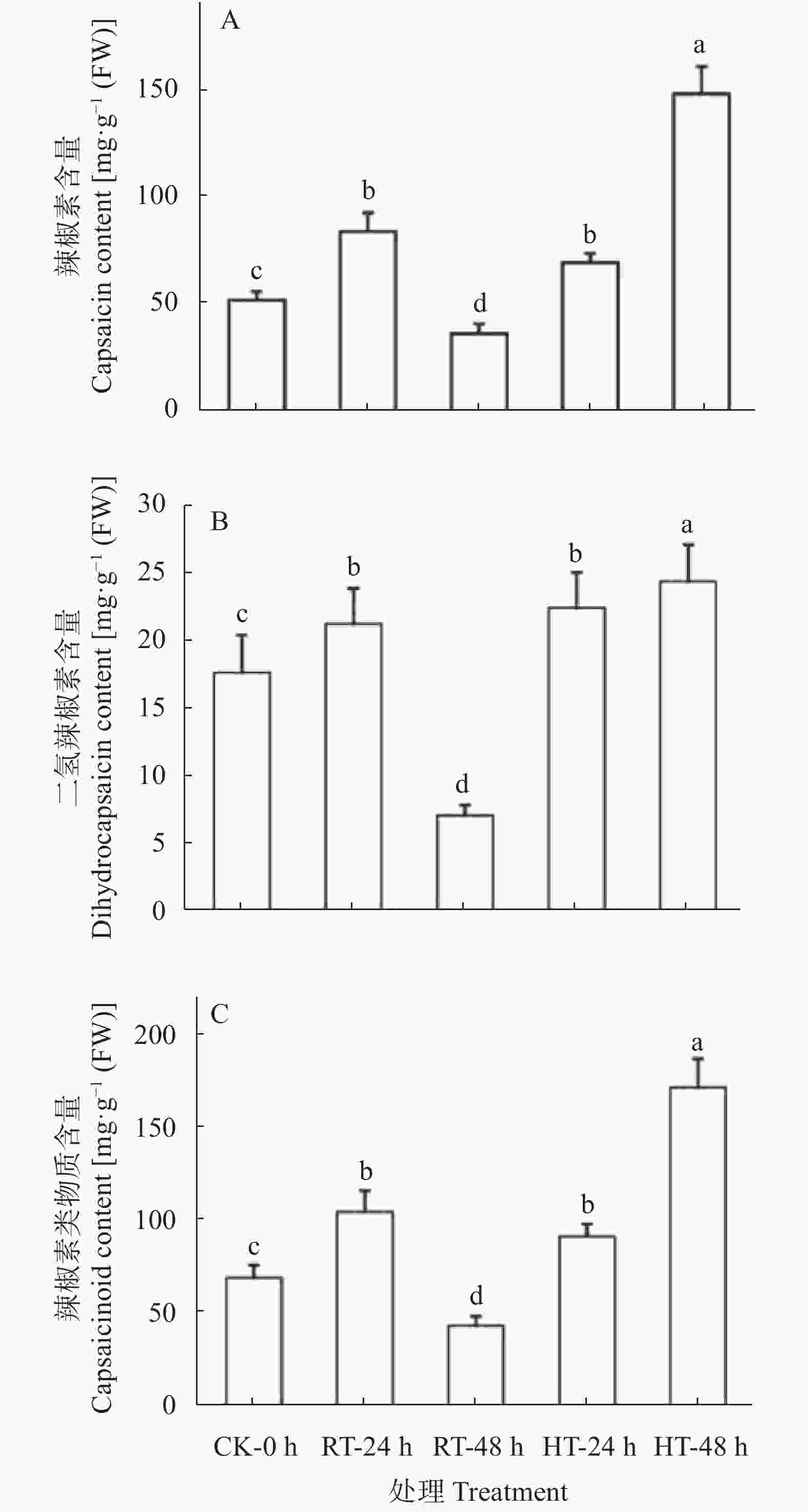
 下载:
下载:
